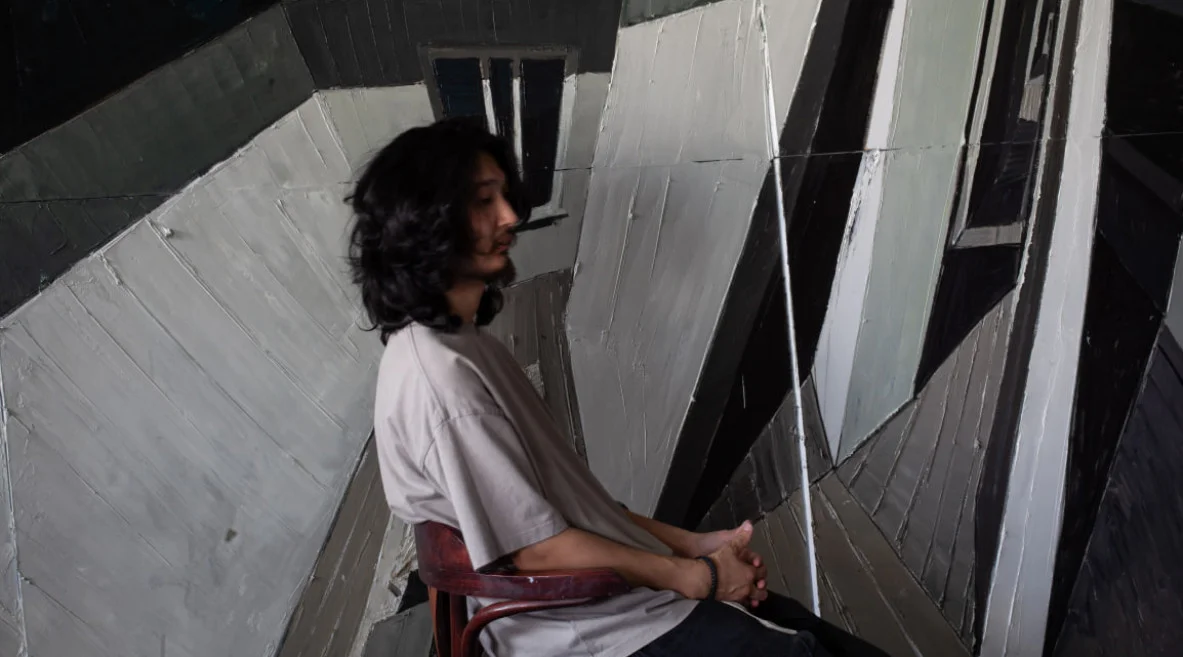
Self-portrait/Sayan Baigaliev
Sayan Baigaliyev, a rising star in the art world and a recent Forbes ‘30 Under 30’ list honoree, is making international waves with his striking ‘sculptural painting’ style, blending bold esthetics with deep, thought-provoking meaning. His work offers a much-needed anchor for a modern audience overwhelmed by information and lost in the digital world. Baigaliyev's work invites reflection and connection in an increasingly disconnected world, and in this article, we explore his evolving oeuvre in greater detail.
Sayan Baigaliyev was born in 1996 in the village of Betkuduk in eastern Kazakhstan and began his artistic journey in Ust-Kamenogorsk (Oskemen). He later attended boarding school and college at the Zhurgenov Academy of Arts in Almaty, where he studied under Guldayria Kasteeva, the daughter of the ‘founder’ of Kazakh art.
In 2016, Baigaliyev moved to Moscow to study at the Surikov Art Institute and joined the renowned Aidan Salakhova’s Modern Art Studio. In 2023, he unveiled his groundbreaking ‘sculptural painting’ technique, which was a fusion of painting, sculpture, and installation that transcends the canvas. By then, he had already participated in prestigious international exhibitions and earned a British art award in 2021.
In 2024, Baigaliyev returned to Almaty, marking a significant homecoming. The ‘Matte(r) Reality’ exhibition at the Kasteev Museum celebrates this pivotal moment in his career.
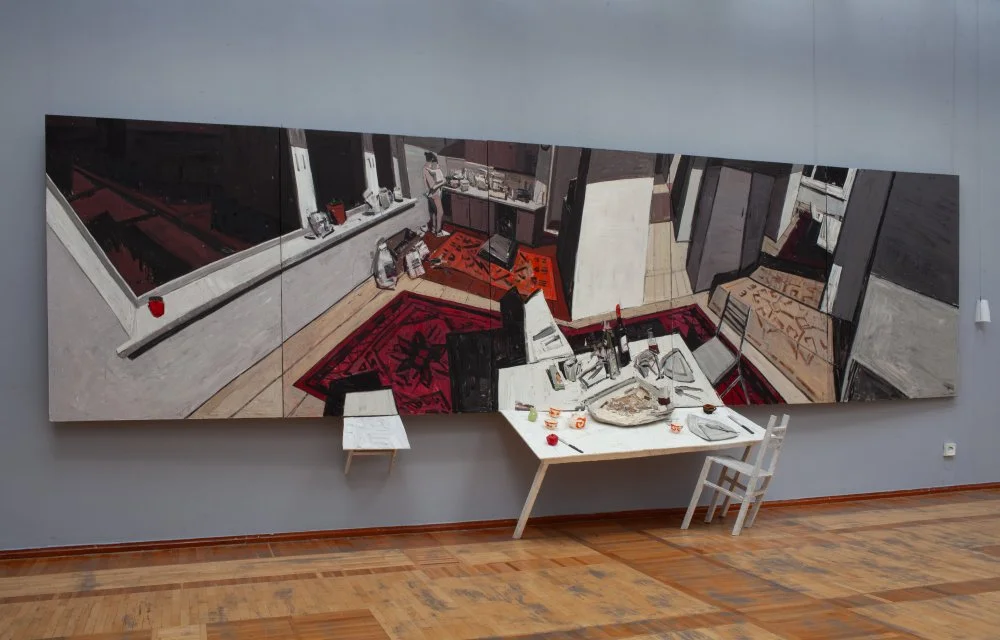
Sayan Baigaliev. «In half»/Andrei Khludeev
In the gallery, the temptation to immediately focus on the vivid sculptural paintings is strong. Their bright, eye-catching appearance draws the viewer in, but this initial allure can make it difficult to notice the subtle nuances of the works. Most of the paintings depict the artist's apartment, with frequent glimpses of his wife and son. This apparent ‘repetition’ helps viewers focus on interpretation, with familiar spaces sometimes transformed beyond recognition.
In the right section of the gallery, relatively ‘older’ canvases are displayed, but even these reveal a key feature of Baigaliyev's work. Four Rooms portrays an entire apartment that cannot be taken in with a single glance, not even from the corridor, the artist's favored vantage point. The corridor serves as a unifying space, enabling movement and connecting the varied lives of the rooms. Yet, for Baigaliyev, a single human perspective is not enough. The outermost rooms are depicted as though seen through surveillance cameras, while the central ones are presented from the normal height of an adult viewer.
In Night in the Kitchen, Baigaliyev transforms an ordinary kitchen scene into a panorama with multiple perspectives. The gaze shifts between the dark corridor and the open cityscape visible through the window. In Awaiting Zhan, the open doors to the entryway and various rooms invite the viewer to ‘peek in’. At the same time, a hallway mirror reflects a corridor that seems to stretch infinitely into the distance. In Zhatagoy, the artist captures every movement of his wife as she cradles their son. Through this ‘supervision’, Baigaliyev conveys a desire to see beyond the visible, his pursuit of hidden dimensions and unseen realities clear.
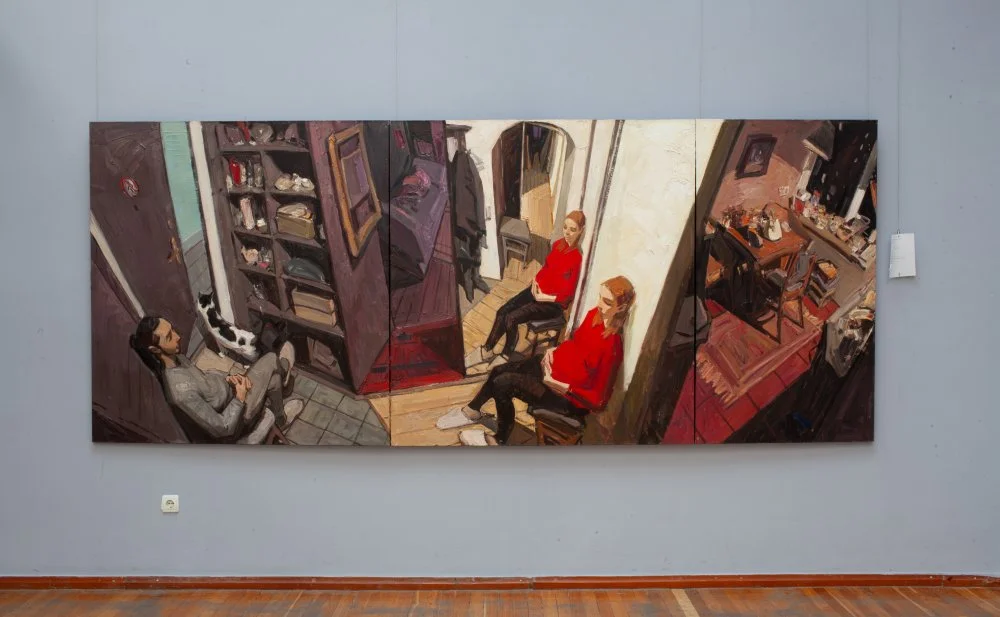
Sayan Baigaliev. «Waiting for Jan»/Andrei Khludeev
It’s intriguing how in Baigaliyev’s work, the home, a space of safety, simultaneously becomes a human-scaled field of exploration. He persistently seeks to push the boundaries of perceiving confined spaces, a tendency evident even in the elongated formats of his canvases. The perpetual chaos of disorder, combined with the distorted forms of objects, imbues things on the canvas with a semblance of independent life. Their abundance offers endless opportunities to study this ‘island’ of space.
Underlying it all is a single message: our ability to interact with reality is highly limited, especially given the fleeting nature of everyday perception. People are content with the tiny fragments of the world accessible to their senses and consciousness and often mistakenly see them as the whole. Baigaliyev feels the constriction of these boundaries and strives to break through to the ever-elusive reality, as if sensing the danger lurking in the loss of our fragile connection with it.
Interiors in his works from 2023–24 (shown in the left section of the gallery) take on a dramatically different appearance. The paintings here are more expressive and charged with nervous energy. The angles of objects and rooms are sharpened, while stark bands of light and shadow slash across surfaces. Warm and bright colors are almost entirely absent from the palette—black, white, and gray dominate, with occasional splashes of red that heighten the overall sense of unease.
The unmistakable (perhaps primary) protagonist of these works is emptiness. Titles like No One in the Corridor and Alone in the Room speak volumes. The theme of solitude is also transparent in the geometric composition of Between Floors, reminiscent of M.C. Escher’s graphics: a forgotten table, a single stool, and a lone cup populate the empty space. The same ‘abandoned human’ motif appears in the corner room of the canvas titled At the End of the Corridor. It would appear that these two works are the most unsettling in the exhibition.
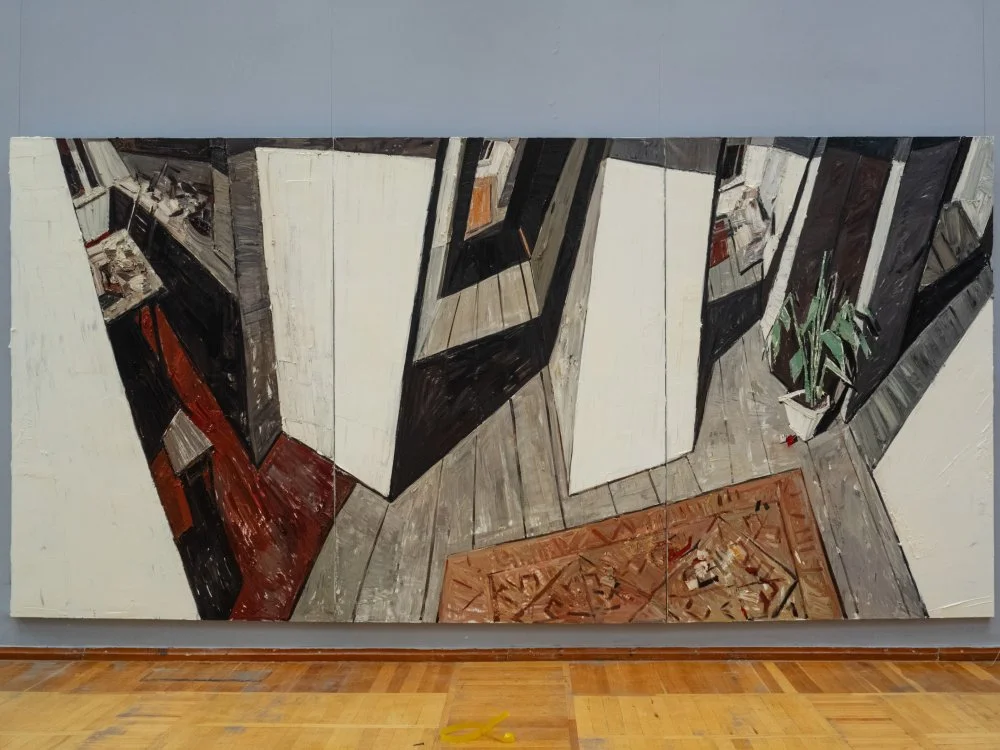
Sayan Baigaliev. «At the end of the corridor»/Andrei Khludeev
The apartment ultimately takes on a cosmic dimension in Baigaliyev’s work, transforming into a labyrinth of an unknowable world. This is perhaps most palpable in The Corridor, where realism dissolves into geometric abstraction. From the darkness ‘at the end of the corridor’, death gazes back at both the artist and the viewer, a visitor from the beyond, cloaked in the guises of fear or anxiety within our world.
The unknown is not just a realm for exploration, endlessly captivating and drawing the subject toward an organic merging with the world. It is also a space where the vulnerability of living beings is acutely felt.
This block of works is partially echoed in Split in Half, the quintessence of still life, which in classical art often reminds us of the transience of existence. The shattered table against the black cosmic background promises that all the dishes will soon fall and break. The chaotic arrangement of objects evokes associations with the fleeing figures in Karl Bryullov's The Last Day of Pompeii. But what’s more intriguing is that the canvas itself and the sculptural jug emerging from it are also ‘breaking apart’—‘death’ occurs not only in the painted world but also in our own space.
In this sense, Baigaliyev’s large painting-sculpture installations are particularly intriguing. In Out of the Room, a table spilling into the exhibition space has yet to find its footing. The dishes are poised to slip off, while a chair frozen mid-fall resembles a child attempting to stand upright for the first time, demonstrating without doubt that fragility and movement are equally inherent to life.
This duality is also present in the central installation Inside the Space Where I Live. A stool, a table, a chair, an easel, and glasses all struggle to maintain balance, and asymmetry reigns here. Everything is askew and imperfect, but it is precisely this imperfection that imbues them with individuality. Painterly expression transforms into the dynamics of an object-as-creature, with its dense texture serving as its vital, pulsating flesh.
The transformation of painting into sculpture should not be dismissed as a mere artistic gimmick or an attempt to ‘update’ supposedly outdated painting. Instead, these works appear to respond instead to a global and perilous trend. Hyper-informational society and the shifting of life online are distancing humanity from natural reality, especially from the aspects that resist rationalization and verbal articulation. The feverish pace of life and the torrent of oversaturated information in media and social networks, dominated by ever-shorter formats, lead to a state of total distraction. The constant need to respond to the signals of a blurred online-offline world prevents a more profound look inward, especially when the surface is crowded with nothing but ‘flashing’ lights.
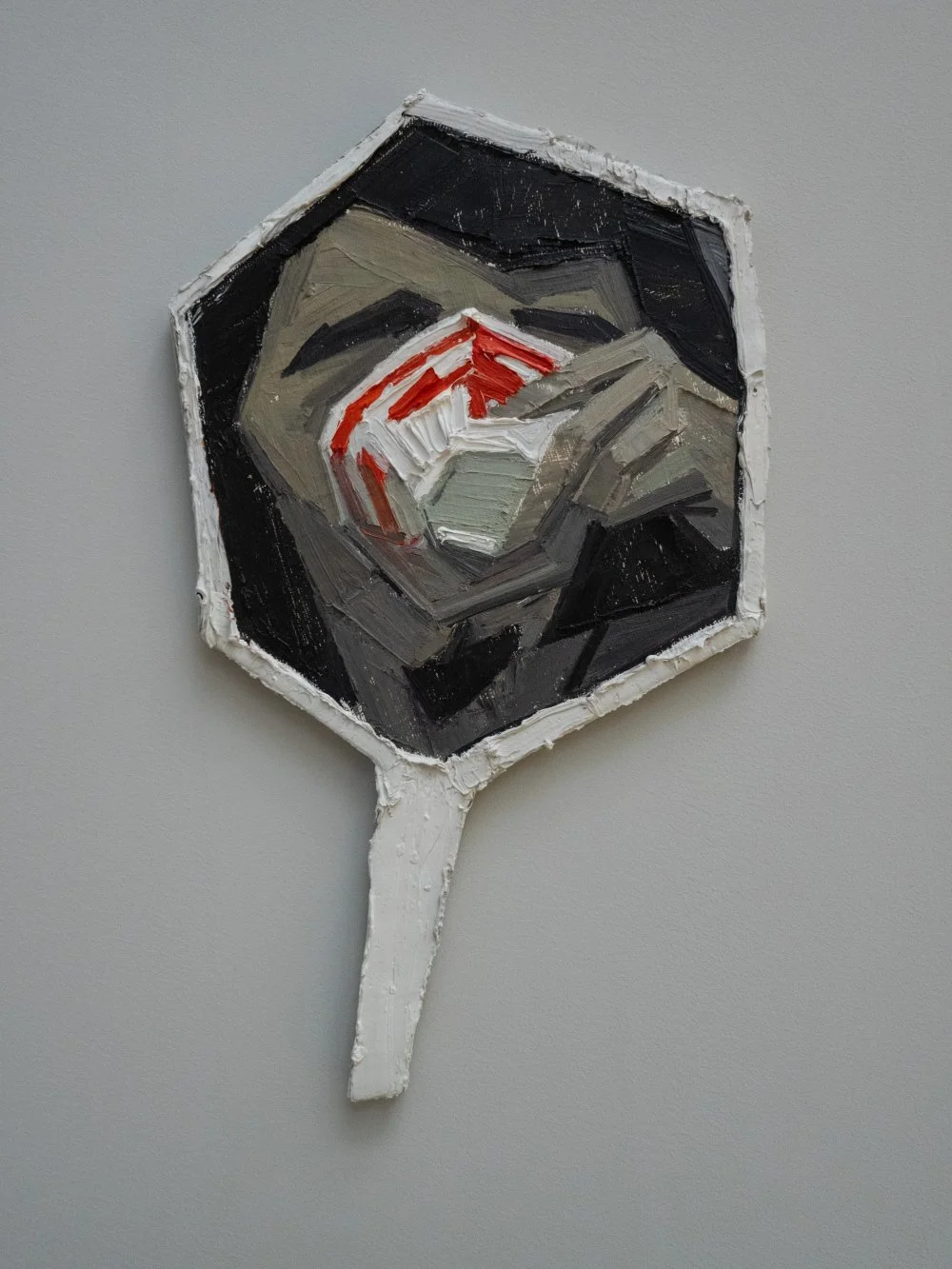
Sayan Baigaliev. Mirror self portrait/Andrei Khludeev
The online sphere inevitably abstracts reality, reducing people to users, media personas, or statistical data, much like news reports summarizing the loss of life as ‘hundreds’ killed in war. Adding to this, propaganda, advertising, or trendy influencers manufacture the illusion of ‘public opinion’ for subscribers who are abstracted into a faceless audience.
The relentless flicker of these illusions forms a kind of screen wall. It prevents individuals from breaking through to reality, a space where perception, awareness, and articulation always point toward the unknown. Yet only there can living beings, with their fluid, fragile, and complex nature, truly exist. Abstractions are too flat to contain their depth, causing them to inevitably lose much of themselves.
However, this is not the only danger. Losing a sense of reality also erodes the ability to empathize, making it far more challenging to connect with users, images, and roles. Moreover, values are blurred, making it difficult to defend what one doesn’t fully believe in, especially in a world ruled by fleeting trends.
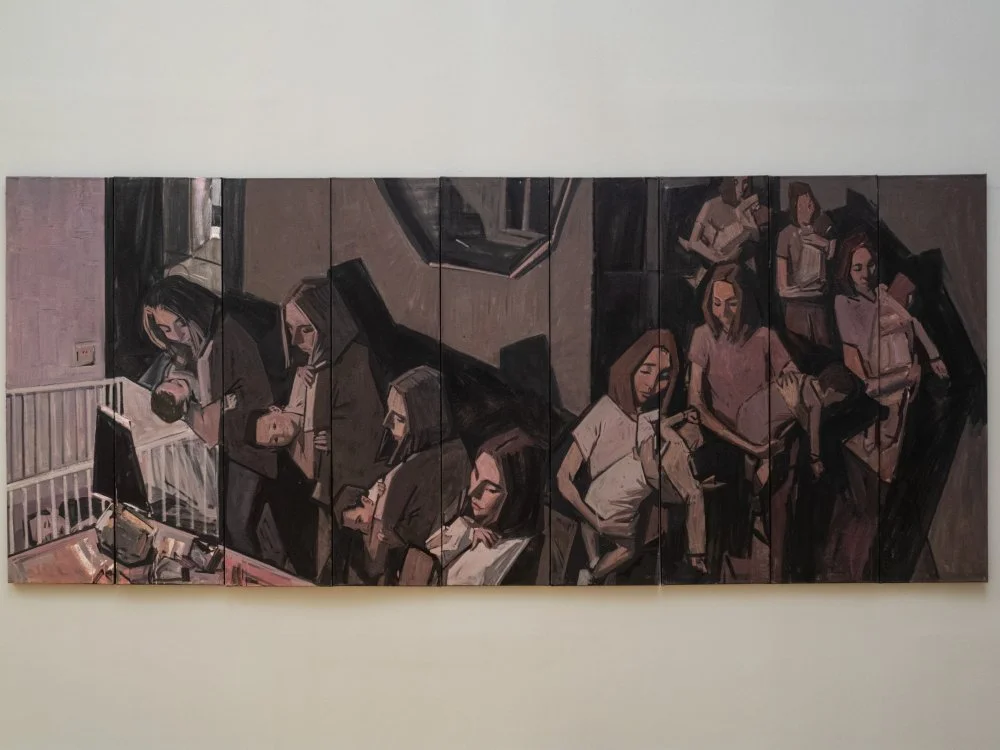
Sayan Baigaliev. «From the room»/Andrei Khludeev
Baigaliyev's sculptural paintings (which, in the gallery, are abundant alongside the large installations, such as, for example, Still Life on a Carpet opposite the entrance) represent a form of de-virtualization. The artist breaks through the flat plane of the canvas-as-screen and extends a vividly textured object toward the viewer. It’s as if he’s inviting them in and saying, ‘Look closely—at the lemon, juicy pomegranates, vases, pitchers, tablecloths, and bowls adorned with enchanting patterns. Do you see how dense, textured, and vibrant they are? This is no longer just an image. This is real…’
The labyrinth of reality can be intimidating, but it is the only place where the fragility and value of life can truly be felt. And exploring it—even with the understanding that its essence can never be fully grasped—remains a captivating experience.